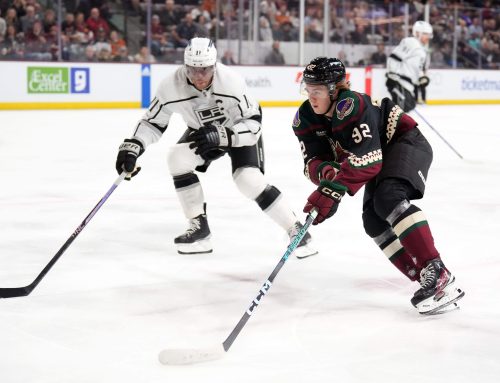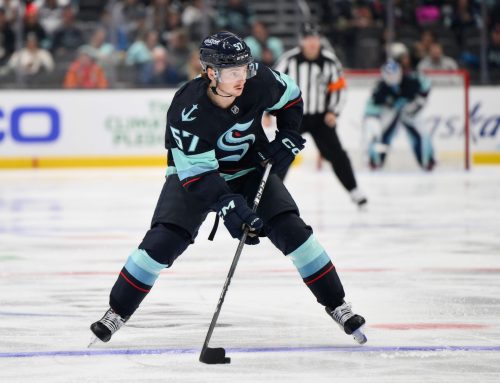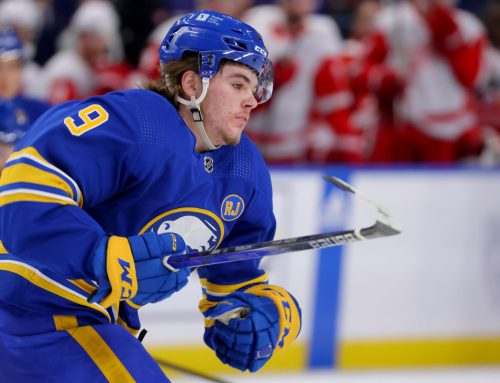The Journey: February Sink-Or-Swim (Glass, Tippett, Roslovic)
Ben Gehrels
2022-02-26
Welcome back to The Journey, where we follow hockey prospects and their paths to the NHL, providing fantasy predictions and analysis along the way.
It's the end of the month again, which means it's time for another edition of sink-or-swim. We’ll examine three former blue-chip prospects whose values have taken a hit and whose futures now seem uncertain. Should you trade them while they still have name recognition or hold until/buy low before they turn things around and get back to their dynamic ways?
Post ideas for future players in the comments or hit me up on Twitter @beegare. This month, the spotlight is on Cody Glass, Owen Tippett, and Jack Roslovic.
Cody Glass, NAS
Glass stocks are at an all-time low, so let’s review how hyped this guy was as recently as two years ago. After going sixth overall in the 2017 draft on the strength of scoring 94 points in 69 games (1.36 points per game) for the Portland Winterhawks of the WHL, he then played two additional years in the WHL, increasing his scoring rate first to 1.59 then 1.82 ppg in his D+2 season. He then scored five points in his first six professional-level games in the AHL.
At that point, he made the cover of The Hockey News' 2019 Future Watch edition as part of "The Big Three" with Cale Makar and Quinn Hughes.
We all know how the other two have turned out, but Glass has yet to deliver on all that tantalising potential. He started seeing NHL action the following year, putting up a respectable 25-point pace as a rookie in 39 games—seeing time alongside Vegas stars Max Pacioretty and Mark Stone. Patches had high praise for the kid: “He has the ultimate hockey tool, and that’s hockey IQ and knowing where to be on the ice. He’s a lot of fun to play with. He’s the future of this team, and I can’t say enough good things about him.”
But then, after some injury trouble (knee) and scoring at a somewhat underwhelming 30-point pace in his sophomore year, Glass was suddenly traded to the Nashville Predators in a three-way swap that sent Nolan Patrick to Vegas. Prior to that final season in Vegas, Glass had rehabbed his knee post-surgery for nine months—leaving him only one month to get into game shape before the 2020-21 season began. In interviews, he's discussed feeling slower that year as a result of the knee issues. Losing a half-step at the NHL level can make all the difference between dynamic and depth scorers.
Drilling a bit deeper into Glass's second season in Vegas (10 points in 27 games), it's worth noting that he actually scored seven of those points in his first eight games that year playing on a line with Alex Tuch and Nicolas Roy. Then Keegan Kolesar replaced Roy and for whatever reason Glass's production plummeted to only two points in his next 12 games. The discrepancy between his even strength (50%) and power play IPP (71%) suggests that the lack of quickness from his knee might have caught up to him. He was involved in the scoring much more often on the power play versus even strength. It's possible that the extra space afforded to him on the man advantage allowed that high hockey IQ to shine while he lagged behind on the fast-paced back and forth play at five on five.
There are two key points when predicting Glass's fantasy upside moving forward: his health and role in Nashville. His 39 points in 43 games with the Milwaukee Admirals of the AHL this year shows that Glass is healthy and back to his dynamic scoring ways. With only 20 games at that level prior to this year, he's basically still a rookie pro—and that is excellent production for a first-year AHL player. It's only a matter of time until the Predators give the 22-year-old a shot, which leads to the second question about his role.
It's always a bit discouraging seeing high-end scoring forward prospects get traded to or drafted by Nashville. Something about their defence-first system and insistent reliance of veterans at the top of the lineup makes it difficult for young players to get the minutes and opportunities needed to shine. Philip Tomasino makes an interesting case study here for how the Predators may utilize Glass once they finally call him up. Tomasino has been getting about 11 minutes per game and minimal power-play time. At even strength, he's mostly been buried down on the fourth line with Thomas Novak and Nick Cousins. He was a former first-round pick by Nashville and has just as much blue-chip pedigree as any other prospect. But the opportunity hasn't been there for him yet.
Glass may see similar deployment. The Predators have been running a top six of Matt Duchene – Mikael Granlund – Filip Forsberg and Luke Kunin – Ryan Johansen – Eeli Tolvanen. And they're unlikely to split up their impactful checking line of Tanner Jeannot – Yakov Trenin – Colton Sissons. So if Glass does get a call-up towards the end of this year, a realistic scenario would see him get a bit of power play time and bump one of Novak or Cousins off that fourth line at even strength to give Tomasino his first offensively talented linemate.
More realistically, Glass will join Nashville at the start of next year—assuming they re-sign him as a restricted free agent (RFA) at the end of '21-22. Kunin, Trenin, and Novak are all RFAs too, while Forsberg and Cousins are both unrestricted free agents (UFAs). Forsberg will likely sign long-term, while Trenin, Novak, and Cousins will probably be signed to shorter contracts as depth pieces. Kunin has struggled to produce and drive play in the top six and is a bit more expensive than the others; it wouldn't be a surprise to see Nashville move on from him. That would leave a spot in the top six for either Tomasino or Glass.
Grab him now before the Glass hype reignites!
Owen Tippett, FLA
Tippett owners have to be worried at this point. Even though the Panthers have been absolutely obliterating other teams on the scoreboard, he's been largely left out of the action—to the tune of a lowly 45% IPP. He hasn't really been driving play despite receiving sheltered deployment, is currently pacing for only 27 points, and was demoted to the AHL two games ago with the return of Maxim Mamin—a depth signing out of the KHL this past offseason.
In the admittedly light plus column, Tippett is only 23 and has another 100 games or so until he reaches his Breakout Threshold. He's a bit reminiscent of Eeli Tolvanen right now —hyped for his goal scoring in junior but mostly just putting up decent peripherals as an NHLer 100 games into his career. Tippett has 1.7 shots and 1.5 hits per game this year while averaging about 12 and a half minutes. If he gets more ice time, both those rates will obviously increase and boost his appeal in multi-cat formats.
It might be understandable for a young player on a contending team like the Panthers to not be playing a major role. But prospects like Anton Lundell and Mason Marchment in particular have established themselves as key pieces for the Panthers this year, leapfrogging Tippett in the process. Carter Verhaeghe did the same last year. There have been several opportunities here but Tippett hasn’t seized them yet and it feels like the clock is ticking at this point.
Tippett is still somewhat attractive in fantasy for his upside (if he comes cheap) but it’s increasingly looking like he’ll live more in the middle six than on the top line scoring buckets of goals as Aleksander Barkov‘s triggerman. That’s Verhaeghe’s job for now. But if you can wait, see what happens a season and a half (106 games) from now when he hits his BT. This is a player that scored 54 goals in 74 OHL games at one point and put up 40 points in 46 AHL games just two years ago. There might still be something here.
Jack Roslovic, CBJ
Roslovic seemed on the verge of stardom last year after scoring at a 60-point pace as a 23-year-old. But then there was a coaching change and now he’s on a 30-point pace with no shots or hits playing under 12 minutes a night with minimal power play time. He seemingly went from potential number one centre to below-average sheltered depth piece just after crossing his 200-game BT.
Does that mean he belongs to that 20% of players who buck the standard breakout pattern?
Not necessarily. This sudden descent makes more sense when you realize Roslovic went from playing 17 minutes a night to only 12 and also lost almost 25% of his power-play time. If he were performing at his current rates but with an extra five minutes every game, Roslovic would be producing at a 50-point pace with two shots and just under a hit per game. That’s not amazing but it is rosterable.
His IPP sits at a respectable 67%, more or less what we expect to see for a solid scoring forward. In fact, Roslovic has never had an IPP below 60 in his five-year NHL career. That suggests he’s often driving his line instead of tagging along. He’s also driving play relative to his teammates, as he did last year. For whatever reason, however, Coach Brad Larsen is giving Roslovic basically the same type of sheltered, offensively advantageous deployment as John Tortorella did. But with far less ice time.
Now that Roslovic is almost a full season over his BT, however, it’s conceivable that last year’s 60-point pace is roughly his ceiling and that fantasy managers should think of him as a 50-point player moving forward instead of 60+—assuming he ever earns back those five minutes. Columbus is retooling on the fly quite successfully by adding talented young players like Adam Boqvist, Jake Bean, and Cole Sillinger without sacrificing much. If Roslovic can prove he belongs in this team’s core, he could benefit as the team comes together in the coming years and get back to producing in the 50–60-point range. Again, rosterable but not amazing.
Thanks for reading! Follow me on Twitter @beegare for more prospect content and fantasy hockey analysis.





 WSH
WSH NYR
NYR NSH
NSH VAN
VAN COL
COL WPG
WPG L.A
L.A EDM
EDM CHI
CHI T.B
T.B CAR
CAR NYI
NYI MTL
MTL
